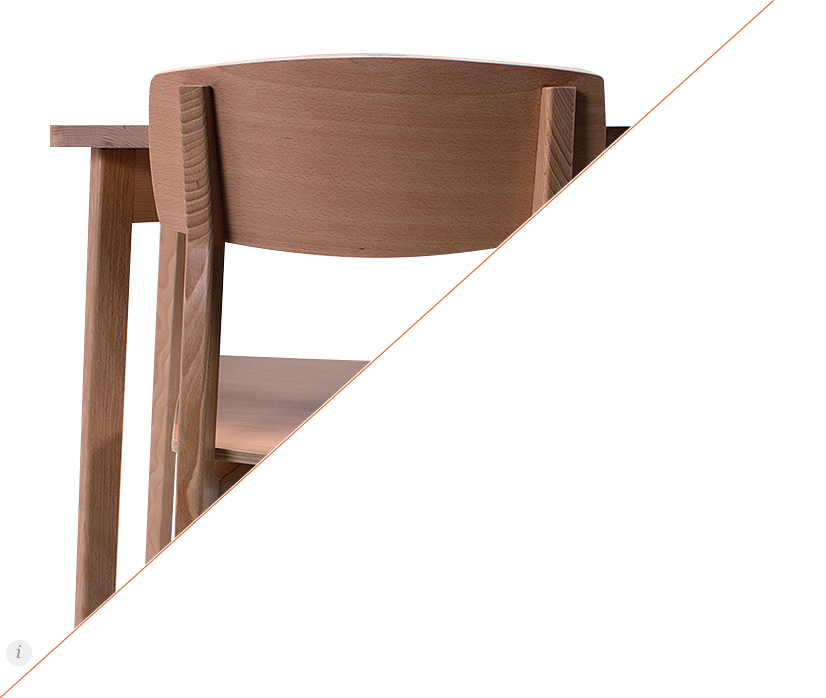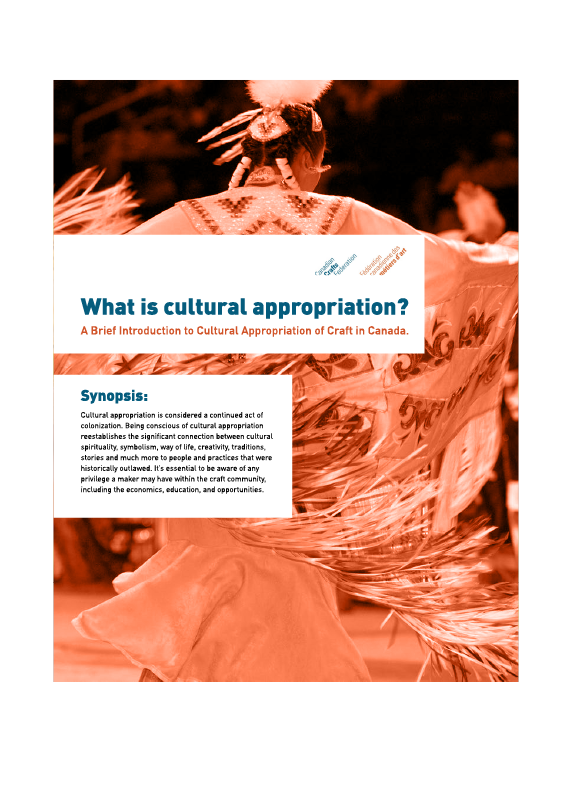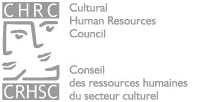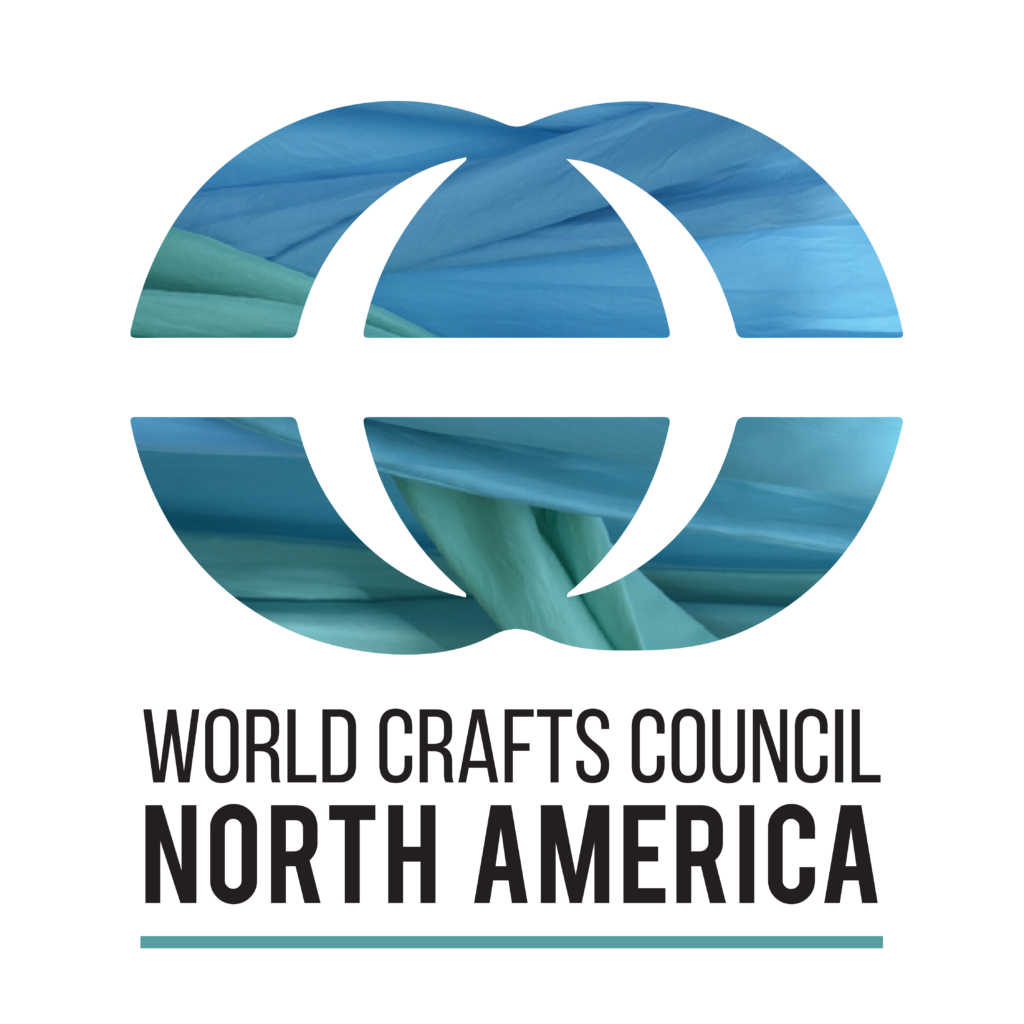Resources
If knowledge is power, and strength is found in numbers, then informing the sector with data, knowledge and contacts is an important part of advancing the craft sector. The following resources are intended to empower you.
Research
Craft Sector Impact: Statistics for the Sector
A thorough survey and follow up reporting was conducted by the CCF/FCMA in late 2019 and early 2020, gathering statistics from 10 Provincial and 2 Territorial Craft Councils. The final calculations were reviewed, vetted, and confirmed by the Executive Directors of each organization surveyed.
DOWNLOAD:
Considering Cultural Appropriation
As the national arts service organization for craft in Canada, the CCF/FCMA encourages artists and the public alike to embrace and value the artistic, economic, historic, contemporary, and social significance of craft. This is no easy feat, particularly in a country as broad and diverse as Canada. The history of this land influences and informs our contemporary experiences, and with this in mind, we recognize that craft practices are intrinsically tied to the past, present, and future.This document takes one small step toward encouraging thoughtful and informed consideration and action regarding the harm of cultural appropriation in craft.
DOWNLOAD:
Pathway to Funding :
Craft & The Canada Council for the Arts
Pathway to Funding: Craft & The Canada Council for the Arts, is live online now, produced by the CCF/FCMA (and voiced and animated by our awesome design intern, Noémie Malenfant). The CCF/FCMA created this animation to demystify the Canada Council’s new model and encourage more applications from the craft sector. As craft artists may not immediately see themselves in the language of the new Canada Council for the Arts funding model, this video aims to encourage that connection.
DOWNLOAD:
London Craft Trade Mission Report
From February 28th to March 4th, 2019, seven leaders from the Canadian craft sector explored the London craft scene, building an arsenal of information and new networks for the future. That information has been compiled in the CCF/FCMA’s London Craft Trade Mission Report, a resource that can be used by Canadian crafts artists and organizations who want to make connections with or learn about the UK craft scene.
DOWNLOAD:
Senator Patricia Bovey’s Speech, Identity: Artists, The Senate & Canada
At the CCF/FCMA’s 2018 national crafts conference in Nova Scotia, “Placemaking: The Unique Connection Between Craft, Community + Tourism, Lunenburg Keynote Speaker, the Honourable Senator Patricia Bovey, gave her speech, Identity: Artists, The Senate & Canada. Click here to read it, and download our graphic below featuring a few highlights from her speech.
DOWNLOAD:
Craft Think Tank Report
From October 19th to the 21st, 2017, the CCF/FCMA participated in the exclusive Craft Think Tank on Craft Education, hosted by the American Museum of Ceramic Art in Pomona, California. For three days, thirty-five delegates (each in attendance by invitation of the organizers) exchanged information and ideas about the state of craft in America. Read through our report on the event, and be immersed in the many resources, references, and ideas shared throughout the event.
DOWNLOAD:
Craft Year 2015 Infographic
Craft Year 2015: the biggest, broadest celebration of contemporary fine craft ever hosted in this country. It’s not just a claim, we have the stats to back it up!
Throughout the year, craft artists, institutions, associations, and the general public took part, attending a record-breaking 884 events, up 25% from our previous number during Craft Year 2007. Find out more about what events took place and where, as well as the online Craft Year experience, in our Craft Year 2015 infographic.
DOWNLOAD:
Infographic: Craft Councils at a Glance 2015
The CCF/FCMA is proud to bring you this visual research compiled over the course of 2015. As an organization of organizations, we know the value of networking and collaboration, and that the impact our members make helps to define the craft community. ‘Craft Councils at a Glance’ showcases the scope of the councils and their work.
DOWNLOAD:
Canadian Culture Satellite Account 2010 (released in 2014)
This paper articulates the Canadian Culture Satellite Account (CSA) developed by Statistics Canada. The Canadian CSA provides measures of the economic importance of culture (inclusive of the arts and heritage) and sport in Canada in terms of output, gross domestic product and employment, for reference year 2010. The biggest take-away from the report is: that culture represents $47.8 billion worth of GDP, and of that total, $2.8 billion is attributed to the Craft sector.
DOWNLOAD:
Profile and Development Strategy for Craft in Canada: 2003
A Study Coordinated by Conseil des métiers d’art du Québec (CMAQ) for The Canadian Craft Federation/Fédération canadienne des métiers d’art (CCF/FCMA) and prepared by Bert Pereboom, Peartree Solutions Inc., October 2003.
This study provides a qualitative and quantitative profile of the craft sector in Canada. It is the first study to utilize a consistent methodology to measure craft activity across Canada. The study was also the first attempt to develop a cohesive domestic and international development strategy for the craft community in Canada. It reveals that the sector is largely populated with skilled craftpersons working in home-based and other small studios producing one of a kind work or production work. Craft activities are estimated to support some 22,600 individuals, generating total output valued at $727 million, and exports approaching $100 million dollars annually, representing 16 percent of craft revenue of the survey respondents.
DOWNLOAD:
- ENGLISH STUDY PDF
- ENGLISH APPENDICES
- Portrait et stratégie de développement des métiers d’art au Canada
- les appendices du rapport
Traditional Craft Trades as Employers and Training Mechanisms for Canadian Youth: 2013
The Vancouver Island University has released a study on what they are calling ‘Traditional Craft Trades’ and the role they play in protecting Canada’s heritage. An interesting take on craft, which includes artistic practices as well as the more agriculturally tied craft activities, the study concludes with more questions we should all consider. (Unfortunately, this study is only available in English).
DOWNLOAD:
Canadian Fine Craft Niche Market Study: 2005
Initiated by the Trade and Investment Development Directorate of the Department of Canadian Heritage, in cooperation with the Trade Team Canada Cultural Goods and Services Working Group (TTC-CGS) for Crafts, this study focuses on the niche connections in crafts. It identifies the trends, habits, experiences, and conditions of Canadian fine craft exporters, as well as the niche market opportunities with particular potential for Canadian fine crafts people.
DOWNLOAD:
Report – Market Intelligence for the Buyers Market of American Craft: 2003
Prepared by Heather O’Hagan, former Executive Director Crafts Association of BC, for the Department of Foreign Affairs and International Trade. Funding provided by the Department of Canadian Heritage, The Canadian Consulate in New York and International Trade Canada.
This report offers detailed information and observations about the Buyers Market from a Canadian participant’s perspective.
DOWNLOAD:
Craft International Trade Action Plan
Developed by Tom McFall, Executive Director of the Alberta Craft Council and Chair of the Trade Team Canada – Cultural Goods and Services Working Group for the Craft sector; Anne Manuel, Executive Director of the Craft Council of Newfoundland and Labrador; Louise Chapados, Director of Development for Services and Exports of the Conseil des métiers d’art du Québec; Rosalyn Morrison, former Executive Director of the Ontario Crafts Council; and Susan Greene, former Senior Trade Officer responsible for Craft with the Trade Routes program of the Department of Canadian Heritage.
Based in large part upon the research and findings presented in the document “Profile and Development Strategy for Craft in Canada,” (see above), the scope of the action plan is limited to recommendations for action on the part of the Government of Canada.
DOWNLOAD:
Marketing Guide for Contemporary Fine Craft in the United States: 2002
Commissioned by the Department of Foreign Affairs and International Trade in 2002. Managed by the Crafts Association of British Columbia, co-authored by Dana Boyle, Business Development Officer with the Canadian Consulate General In Minneapolis, Minnesota, and Lou Lynn, artist and faculty member at the Kootenay School of the Arts in Nelson, British Columbia.
The guide is a source of information for craftspersons interested in entering US markets or expanding their US exposure. Topics include: Getting Ready to Go, Working with Galleries, Preparing to Export and Border Issues. Also included are: tips for preparing portfolios; advice about approaching US galleries; descriptions of wholesale and retail shows; and more.
Find recommendations for converting your prices for selling in the US market, classifying your work for US customs, finding customs brokers, shipping, working with embassies and consulates, and much more.
DOWNLOAD:
Study of the Crafts Sector in Canada: Inventory and Summary of Current Literature; Defining the Crafts Sector; Working Together to Develop the Crafts Sector: 2001
Coordinated by Conseil des métiers d’art du Québec (CMAQ) for the CCF/FCMA. Prepared for Industry Canada and the Department of Foreign Affairs and International Trade (DFAIT) by Bert Pereboom, Peartree Solutions Inc.
DOWNLOAD:
Education
Craft Education Across Canada
BRITISH COLUMBIA
- Kwantlen University College | Bachelor of Design | Fashion & Technology
- University College of the Fraser Valley | Fashion Design Diploma
- Emily Carr Institute of Art + Design | Bachelor of Fine Arts | Ceramics
- Selkirk College | Kootenay School of the Arts
- Langara College | Fine Arts Diploma | Ceramics
- Vancouver Community College | Jewellery, Gemmology, Fashion Design and Production.
For a complete listing of educational institutions, including summer school and private and part-time opportunities in British Columbia, visit the Craft Council of British Columbia’s website.
ALBERTA
- Alberta University of the Arts | Bachelor & Masters of Fine Arts | Ceramics, Jewellery + Metals, Glass, and Fibre
- Red Deer College | Series Summer School | Ceramics, Wood, Glass, Metal, Fibre
- Northern Alberta Institute of Technology | Woodworking, Blacksmithing
- Portage College | Unlock Your Creative Potential
SASKATCHEWAN
- University of Saskatchewan | Jewellery, Fibre Art, Glass, Printmaking
- University of Regina | Bachelor of Fine Arts and Masters of Fine Arts | Sculpture, Ceramics and Printmaking
- Timeless Instruments School of Luthiery | Luthier programs
MANITOBA
- University of Manitoba | Ceramics
ONTARIO
- Georgian College | Jewellery & Metals, Goldsmithing & Silversmithing
- OCAD University | Bachelor of Design or Bachelor of Fine Arts in Material Art & Design | Master of Design/Master of Fine Arts/Master of Design in Interdisciplinary Master’s in Art, Media and Design (IAMD)
- Sheridan College | Bachelor of Craft & Design |Textiles, Ceramics, Furniture, Glass
- George Brown College, Centre for Arts & Design | Fashion, Jewellery
- Seneca College | Fashion Arts Diploma Program
- Ryerson University | Bachelor of Design and Master of Arts in Fashion
- Fleming College, Haliburton School of the Arts | Blacksmithing, Ceramics, Jewellery, Glassblowing, textiles
QUÉBEC
- Institut des métiers d’art : Cégep du Vieux-Montréal | Céramique, Construction Textile & Impression Textile, Ébénsterie artisanale, Joillerie, Lutherie-guitare, Maroquinerie, et Verre
- Centre de formation et de consultation en métiers d’art :Cégep de Limoilou | Céramique, Construction Textile, Ébénsterie artisanale, Joillerie, et Lutherie
- Concordia University | Bachelor of Art in Ceramics and Fibre
- Espace Verre | Glass
- École de joillaire | Jewellery
- Centre de design et impression textile de Montréal | Textiles
- Centre des textiles contemporains de Montréal | Diploma & Workshops in Textiles
NEW BRUNSWICK
- New Brunswick College of Craft and Design | Diplomas in Aboriginal Visual Arts, Ceramics, Fashion Design, Jewellery/Metal Arts, and Textile Design
NOVA SCOTIA
- Nova Scotia College of Art & Design University | Bachelor of Fine Arts in Ceramics, Jewellery Design & Metalsmithing, Textiles & Fashion
- The Cape Breton Centre for Craft & Design | Workshops | Clay, Jewellery, Textiles
- Nova Scotia Centre for Craft & Design | Workshops | Glass, Clay, Wood, Textiles, Jewellery
NEWFOUNDLAND & LABRADOR
- College of the North Atlantic | Textiles: Craft & Apparel Design
- Craft Council of Newfoundland & Labrador | Clay Studio Courses
NUNAVUT
- Nunavut Arctic College | Fur Design & Production, Jewellery & Metalwork, Goldsmithing
NORTHWEST TERRITORIES
- Aurora College | Traditional Arts Certificate
YUKON
- Arts Underground | Workshops in Textiles, Clay and Glass
Resources
CARFAC (Canadian Artists’ Representation/Front des Artistes Canadiens) is a national nonprofit group dedicated to defending Canadian artists’ economic and legal rights. They also direct research and promote Canadian art. Fee schedules, copyright information, and other invaluable information can be found on their website or through a provincial representative.
Copyright Visual Arts is a not-for-profit copyright management society providing Author’s Rights administration for professional Canadian and Québécois visual and media artists.
Cultural Pluralism in the Arts Movement Ontario (CPAMO) is a movement of Indigenous and racialized artists engaged in empowering the arts communities of Ontario. CPAMO seeks to open opportunities for Indigenous and racialized professionals and organizations to build capacity through access and working relationships with cultural institutions across Ontario that will result in constructive relationships with Indigenous and racialized professionals and organizations.
The Cultural Human Resources Council has multiple studies on employment and careers in the Canadian cultural sector. The CHRC also provides extensive information in both official languages about opportunities for cultural employment, including Craft. Here you can learn about what it takes to work in any given cultural field, browse Internship programs and Job opportunities, review research studies, and more. Of particular interest is the Art of Managing Your Career, a resource guide for cultural careers in all fields, with detailed information about the craft sector as a whole in both English and French.
CERF+ (the Craft Emergency Relief Fund and Artist Emergency Resources) is the resource for craftspeople looking for information on emergency preparedness and how to deal with a disaster. Information is available on their website about safeguarding, disaster planning, cleanup, salvage and e-salvage, and is freely accessible online to Canadians.
The Indigenous Curatorial Collective / Collectif des commissaires autochtones (ICCA) engages in critical discourses, increases professional opportunities for our members, develops programming, and most importantly works to build reciprocal relationships with Indigenous curators, artists, communities and the institutions we engage with.
The World Craft Council North American Region (WCCNA) is one of five regions represented in the World Craft Council International (WCC) organization. Volunteers power the effort of the WCCNA, to encourage connections and build networks between North American craft and the rest of the world, ensuring that Northern American, Central American, and Caribbean craft is known and appreciated as a reflection of our collective, unique and diverse North American culture.












